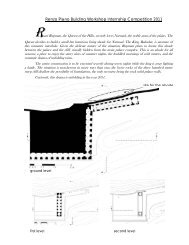the City Edge
the City Edge
the City Edge
You also want an ePaper? Increase the reach of your titles
YUMPU automatically turns print PDFs into web optimized ePapers that Google loves.
The Walled <strong>Edge</strong><br />
<strong>the</strong> earliest cities had no need for walls.<br />
Most of <strong>the</strong> time, <strong>the</strong> natural<br />
topography of <strong>the</strong> land was defense<br />
enough. Border cities had some sort of<br />
fortifications but o<strong>the</strong>rwise, walls were<br />
more a matter of allegiance than<br />
defense.<br />
The walls were dispensed with when<br />
<strong>the</strong> political power was strong and<br />
wanted to show off its glory by <strong>the</strong>ir<br />
removal, such as <strong>the</strong> Ottoman empire.<br />
In absence of <strong>the</strong>ir own defenses,<br />
settlements depended on a central<br />
fortified zone, to escape to when in<br />
danger. O<strong>the</strong>r means were to build <strong>the</strong><br />
outermost houses in a tight ring of<br />
walls with a windowless periphery.<br />
The presence of a definite physical<br />
boundary limited <strong>the</strong> city‟s expansion,<br />
also it made it effective in protecting<br />
market privileges.<br />
THE CITY EDGE<br />
The Catal huyuk, Turkey.: note <strong>the</strong> tight<br />
clustered formation of houses with one continuous<br />
wall<br />
The Chaco culture, New Mexico. Urban form as<br />
measure of defense
















